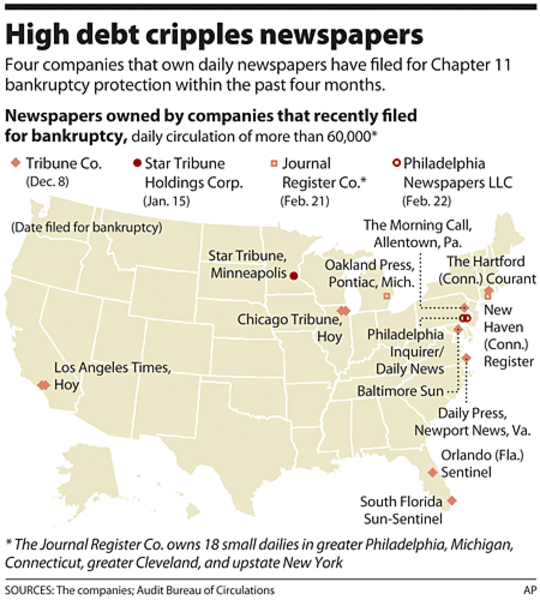Newspapers' troubles escalate in recession
| New York
It's the worst of times for the newspaper industry, and it's not the best time, either, for finding solutions amid a crisis of downsizings, bankruptcies, and closings.
The steep recession, on top of a fundamental shift of readers from print newspapers to the Internet, has caused local papers' ad revenues to fall off a cliff. The Tucson Citizen is the latest to announce it will stop publishing if a buyer isn't found by March 21.
Plenty of ideas exist to develop new streams of revenue for the news business, such as a micropayment system like iTunes for a nickel-a-click read of an article or the creation of nonprofit news organizations to fulfill the traditional role of the fourth estate.
But the Project for Excellence in Journalism, in its "bleakest" assessment yet on the state of the media, says in a report released Monday that the industry must expand its search for solutions far beyond those revenue ideas because "no one source is a likely magic bullet."
"In the last year, the business model has deteriorated so quickly it's now 'man the battleships,' " says Mark Jurkowitz, the project's associate director.
Troubles at The Tucson Citizen are reflected across the industry. The Seattle Post-Intelligencer is expected to print its last edition this week and may publish exclusively online, akin to a decision at The Christian Science Monitor to publish its daily edition online only. In Colorado, The Rocky Mountain News closed Feb. 27. The Chicago Tribune and the Philadelphia Inquirer are owned by bankrupt companies. Others, like the Miami Herald, are on the auction block. Indeed, the prospect of a "no-paper" town is a real one.
If the industry dreads that prospect, the public doesn't seem particularly perturbed. Just one-third of Americans say they'd miss reading their local newspaper, the Pew Research Center for the People and the Press recently reported. Some 43 percent say civic life in their communities would be hurt "a lot" if the local paper ceased printing.
In an ironic twist, the rapid deterioration of the newspaper business is occurring even as the appetite for news is growing, at least online. The problem is that Web readers expect the content to be free of charge.
"In a world where you can get other [free] versions of most stories ... the question is: Is there sufficient incentive to click on a pay model?" says Bill Mitchell of the Poynter Institute, a nonprofit media research foundation in St. Petersburg, Fla.
When newspapers first migrated to the Net, many experimented with pay models for online content – from subscriptions to one-time payments for archived stories. The New York Times tried TimesSelect, which charged online readers for access to columnists, archives, and early access to some stories. But few of those models succeeded. The Wall Street Journal is the only major newspaper that continues to require a subscription to read it online. The New York Times abandoned TimesSelect last year.
The current economic downturn, however, is causing the Times to rethink online payments, said Times publisher Arthur Sulzberger Jr. at a March 12 conference on the media at Stony Brook University in New York.
"The trick, of course, is to garner incremental revenue from the user without significantly cannibalizing the high-rate ad pages that now account for a very significant amount of money," he said.
The notion of an iTunes-like micropayment system is not new, and some media analysts dismiss it, arguing that it's already been tried and rejected by readers. But others say it may be possible to generate some revenue from a pay-per-read model, particularly among younger Web users.
"The younger generation, people in their teens and early 20s, are used to a variety of little payment methods, whether they're using TipJoy [a micropayment system] on Facebook or using iTunes," says Walter Isaacson, president and CEO of the Aspen Institute in Washington, D.C. "They're more adaptable than the older ones ..., who grew up with the Web and don't want to see it change."
Other analysts suggest that the media should focus on creating more nonprofit foundations, like ProPublica, to produce high-quality news. But the Project for Excellence in Journalism, in its report, argues that "it is unlikely that there is enough funding to become a general ownership model." The report urges media executives to consider other ideas:
•Adopt the cable model, in which a fee to news producers is built into monthly Internet-access fees consumers already pay.
•Build online retail malls within news sites to create a local search network for small businesses and link them directly with consumers.
•Develop subscription-based niche products for elite professional audiences, which have already proved to be a profitable growth area in journalism.
•Collaborate to challenge aggregators, especially Google, to start sharing more revenue.
"Newspapers have to get through this really difficult time right now," says Rick Edmunds, the Poynter Institute's media business analyst. "But even after this recession ends, they're still going to need additional revenue streams.






